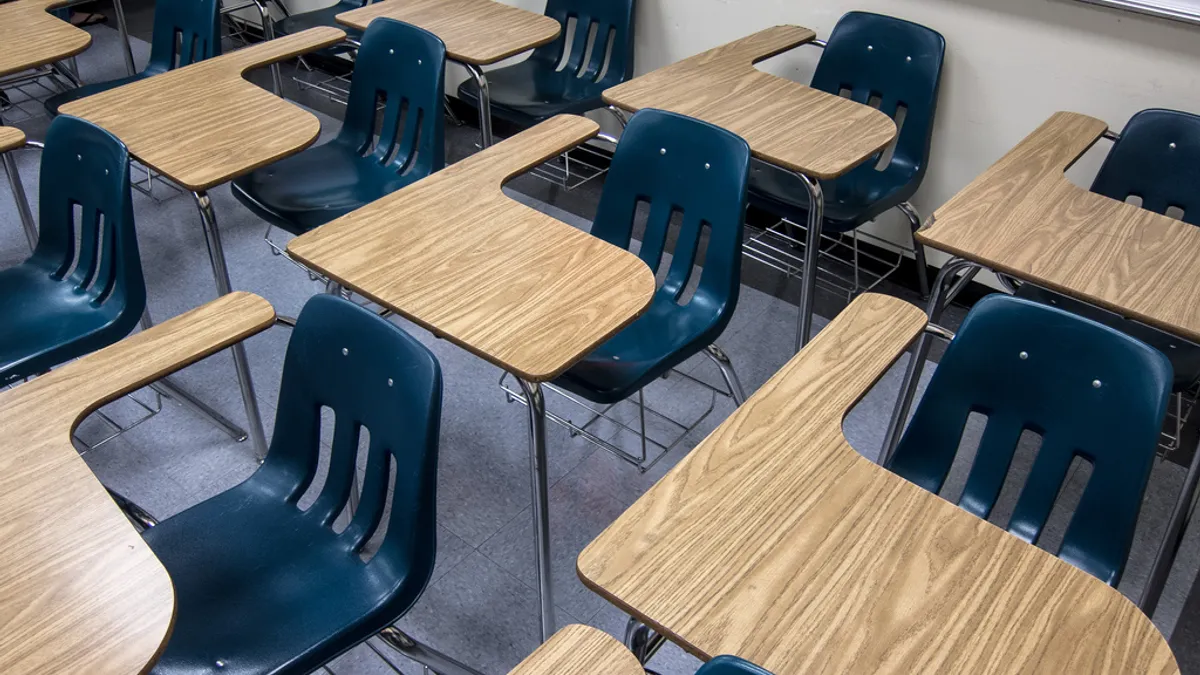Every student in the tuition-free charter network of Individuals Dedicated to Excellence and Achievement (IDEA) Public Schools wears a collared polo shirt emblazoned with the motto "No excuses." All wear white socks, plain black belts, and black shoes with black shoelaces. Male students have to keep their hair short and neat, above the neck, and high schoolers can’t have facial hair. High school girls can only wear “light” makeup and “natural” hair colors, with earrings no larger than an inch.
But those are just cosmetic examples of the kind of attention to detail stressed by the popular and successful chain of charters.
Inside, each member of the majority Hispanic student population adheres to strict academic requirements: mandatory AP classes, “social pressure” to attend college, and another IDEA slogan: "sweat the small stuff."
“This school is not for everyone,” one anonymous parent posted on GreatSchools.org. “It is for anyone willing to work hard with the goal of preparing to excel in college and life.”
Students have complained of high stress levels and too much homework. The Washington Post ranked seven IDEA charters among the 1% of the nation’s most challenging schools.
But the hard work leads to amazing results. Thus far, the charter network is on track to realize its lofty goal of becoming to largest creator of college graduates in South and Central Texas. Over the course of fifteen years, the network's 44 schools in the state have boasted a graduation rate of 100%. Each campus consists of two schools: one K-5 academy and a college prep school for grades 6-12.
The network’s first campus, its Donna, Texas flagship, graduated its first class of seniors in 2007. A whopping 100% of the grads were accepted to 4-year colleges and universities in advance of leaving IDEA Donna, the network says on its website.
But the 100% acceptance rate isn’t just for IDEA’s starting class of 2007. The network maintains that it has kept that seemingly miraculous number running for nine straight years.
“IDEA was — and still is — ensuring that 100 percent of its senior class each year is accepted to a college or university,” former NBA player and IDEA board member David Robinson wrote in an editorial earlier this year.
But is it true? And if so, how do they do it?
Fifteen Years of Growth
Yet IDEA’s meteoric rise and largely unchallenged success hasn’t been without fits and spurts of controversy.
Founded in the 2000 by Tom Torkelson and JoAnn Gama, both Teach for America grads, the first IDEA school opened in Donna, Texas, with just 150 students. Torkelson, a graduate of Georgetown University, first came to the area as a fourth grade teacher within the Donna Independent School District.
A few years later, at age 24, Torkelson launched the charter network's first school.
“My initial optimism turned to quiet outrage, however, as I learned the odds facing students in Valley communities,” he wrote in a 2014 newspaper op-ed. “The average 18-year-old high school graduate from our region performed on par with the rest of the country’s average eighth-grader.”
By 2011, he wrote, IDEA alumni were graduating college “at three times the national rate of students from similar socioeconomic backgrounds.” The IDEA network, he claimed, had already become a national leader.
Also in 2011, the Austin Independent School District announced plans to let IDEA take over its failing Allan Elementary School, where a reported 95% of students are low-income. Parents and community members protested, and students were yanked from school. A year later, in 2012, the district’s board of trustees decided to cancel the arrangement with IDEA.
“This is certainly the most complex and intricate partnership with a district that we or really almost any charter school in the state of Texas has tried," Torkelson told Texas radio station KUT at the time. He then reportedly suggested in a conference call that the Austin school board's vote to cancel the IDEA contract might make it the “most knee-jerk reactionary board in the nation.”
The charter forged ahead anyway, with ambitious plans to build a new campus in Austin. By March 2014, IDEA was breaking ground on a $13 million dollar campus in East Austin, featuring both a primary and secondary school on 10 acres of land.
Local media reported that IDEA took 80% of the students who formerly attended Allan Elementary with them, costing the district “about $60 million over the next seven years.”
IDEA also weathered a mini-scandal in which “sensitive emails” written by Torkelson and sent to his senior management team were leaked to local education leaders and businesses.
“…Several exposed — often quite bluntly – the potential, or lack thereof, for teachers to advance into leadership roles,” South Texas newspaper The Monitor reported, adding that the emails also exposed the charter network’s preference for Teach for America recruits.
Another public point of contention has been Torkelson’s own salary. In 2012, the Monitor reported that he made a “a base salary of $299,000 annually with bonus, fringe benefits and deferred compensation that could add up $397,000,” making him the highest-paid school administrator in the county. According to IDEA’s 2014 990 forms, Torkelson’s total reportable compensation in 2013 totaled $373,307.
Still, despite the occasional troubles, the charter network has grown quickly, winning a variety of awards and grants along the way. It’s been nominated for a 2015 Broad Prize for Public Charter Schools, and this year, six IDEA charter schools received a gold medal ranking from U.S News and World Report. They were also named a "Bright Spot in Hispanic Education" for 2015 by The White House Initiative on Education Excellence for Hispanics. IDEA has secured tens of millions of dollars in grant money from the U.S. Department of Education, including a Race to the Top grant.
Today, the student body has swelled to 1,459, 99% of which are minority students and 87% economically disadvantaged.
Enrollment and advancement
Yet not just any student can enroll at IDEA.
According to the network's student handbook, kids and teens with a history of disciplinary problems that include a criminal offense, a juvenile court adjudication, or “other disciplinary problems” as defined by the Texas Board of Education can be excluded from enrollment.
Moving up through the grades is also contingent on passing standardized tests. To reach grades six and nine, all IDEA enrollees must pass their fifth and eighth grade State of Texas Assessment of Academic Readiness (STARR) exams. They’re afforded a total of three tries, with additional special instruction to help prepare. Otherwise, they’re held back.
Penn State's Dr. Edward J. Fuller is perhaps IDEA’s most outspoken critic. In a 2011 paper “Are IDEA Charter Schools a Good Idea for Austin?” and in various blog posts, he’s accused the charters of “skimming” the best and brightest students for admission.
His report was funded in part by the Texas American Federation of Teachers in order to examine three particular claims made IDEA administrators. Among them: IDEA's education of “underserved” student populations, that all graduates enroll in post-secondary programs, and that its charters outperform other schools.
Dr. Fuller concluded that, compared to other schools in its market, “IDEA schools enroll lower percentages of economically disadvantaged students, special education students, bilingual education students, [and] students requiring modifications or accommodations on the Texas Assessment of Knowledge and Skills (TAKS), and students scoring below average on the TAKS mathematics or TAKS readings tests.”
The charter network has repeatedly denied accusations of cherry-picking students, which go back to at least 2013 from San Benito School Superintendent Antonio Limon, who said it "weed[s] out those who don’t meet their criteria and we get them back."
Regarding graduation rates, Dr. Fuller noted, "If we consider the number of students starting in the 9th grade as the cohort of students of interest, then the percentage of IDEA students entering post-secondary institutions of higher education is, at best, around 65% for the cohort of 9th grader students in 2009."
He also concluded that the network's high performance can be attributed to it losing a greater proportion of lower-performing students than higher-performing ones, and that this disproportion ultimately boosts overall TAKS scores at school and district levels.
IDEA publicly disputed the academic’s claims, saying that its success was entirely due to its students’ hard work.
According to its student handbook, posted online, graduation is possible “only if the student successfully completes the curriculum requirements identified by the SBOE, has been accepted into a 4 year college or university, has completed a minimum of 125 hours of community service, and has performed satisfactorily on required end of course assessment instruments.”
That appears to mean that IDEA students can’t graduate or get their diploma without first being accepted to college — a surefire way to guarantee a continued college acceptance rate of 100% for exiting seniors.
IDEA did not respond to requests for comment by the time of publication.
In his report, Fuller also contested IDEA’s claim that all graduates get into 4-year colleges and universities, writing, "Data from the Texas Higher Education Coordinating Board (THECB ) directly contradicts this claim for every cohort with available data." Existing data showed that “between 6% and 11% of graduates entered two-year colleges.”
“While a high percentage of IDEA graduates enter Texas four-year universities, many of these students perform very poorly once enrolled,” he concluded, based on tracking information from the THECB.
“I found that only 65% of such students remained enrolled in an IDEA Charter Schools as of the 2010-11 school year,” Fuller told the Austin Chronicle. “Thus, the claim made by IDEA that 100% of IDEA graduates entered college is misleading in that such a claim only focuses on those students who actually made it to graduation in an IDEA Charter School.”
He went on to explain that he believed a notable number of thiose entering in ninth grade didn't complete high school in the cahrter network, and that even with those enrolled in eighth grade, less than 85% remained by 11th grade. "Thus, the claim about 100% of graduates entering college is true, but misleading.”
Data from the THECB’s tracking of college enrollment for Texas students in 2014 seems to support Dr. Fuller’s arguments.
Looking Ahead
As for the future, IDEA reported that its overall graduating class of 2015 has been accepted to more Ivy League schools than ever before. Out of 544 students matriculating to college, 62% will be the first in their families to attend college.
The network plans to open four more Texas schools in 2015-16, in Austin, San Antonio, Brownsville, and McAllen. By 2017, it plans to have a total of 60 schools in the network, in order to be “on track to become the largest producer of low-income college graduates in the RGV…. fundamentally changing the economic landscape for our communities.”
Would you like to see more education news like this in your inbox on a daily basis? Subscribe to our Education Dive email newsletter! You may also want to read Education Dive's look at how K-12 school leaders can make the most of Twitter.



















